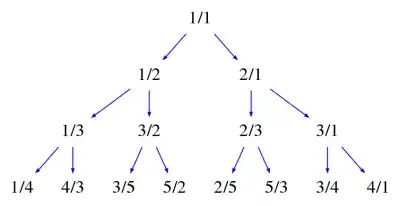Definition: The Calkin-Wilf tree is an infinite binary tree in which each vertex is associated with a positive rational number expressed as an irreducible fraction $a\over b$; in particular, the number $1 \over 1$ is associated with the root vertex. Each vertex $a \over b$ has a left child whose value is $a \over a+b$ and a right child whose value is $a+b \over b$.
Observation 1: Each vertex has a left child whose value is less than 1, since $a<a+b$. Similarly, each vertex has a child on the right whose value is greater than 1.
Observation 2: The sum of the numerator and denominator of the first child is $2a+b$, while that of the second child is $a+2b$; in both cases the sum is greater than that of the parent $a+b$. It follows that by going down the tree, a strictly increasing sequence of sums is always obtained. On the contrary, going up the tree always results in a strictly decreasing sequence of sums.
I propose the following proofs.
Every rational number appears at least once
The parent of any rational number can be determined after expressing the number as an irreducible fraction $p \over q$, i.e. such that the greatest common divisor of $p$ and $q$ is 1. If ${p \over q}<1$, the parent of $p \over q$ is $p \over {q-p}$; if ${p \over q}>1$, the parent of $p \over q$ is ${p-q} \over q$. Therefore, the parent is a fraction whose sum of numerator and denominator is either $p$ or $q$, and in both cases it is less than $p+q$, which is the sum corresponding to the child fraction $p \over q$. It follows that a repeated reduction of this type must sooner or later reach the irreducible fraction with minimum sum, that is, the number $1 \over 1$. This is an informal proof that every rational number appears at least once as the vertex of the tree.
More simply: Among the fractions that do not appear in the tree, let $p \over q$ be the fraction with minimal sum $p+q$. If ${p \over q}=1$ then it appears at root, contradiction. If ${p \over q}>1$ then $p-q \over q$ does not appear, otherwise its right children would be $p \over q$. If ${p \over q}<1$ then $p \over {q-p}$ does not appear, otherwise its left children would be $p \over q$. In both cases there is a fraction not appearing whose sum ($p$ or $q$) is less than the minimal, which is a contradiction.
Any rational number can appear at most once
Furthermore, the parent formula provides for each step a unique sum value which is lower than the previous one, therefore, given any rational number, the sequence of sums to go up from the associated vertex to the root is unique and strictly decreasing (as already observed above). Assume there are two distinct vertices with the same rational number. Due to the structure of tree graphs, going up the tree from each one would sooner or later arrive at the same vertex. Since the sequence of sums is strictly decreasing, the number of steps taken to reach this vertex from each of the two starting vertices must be the same, otherwise we would have two distinct sum values for this vertex. In other words, the two sequences of sums, as well as being equal, are also synchronized. It follows that the two children of the common vertex (which correspond to the previous step of the sequences) have the same sum value, which is in contradiction with the definition of the tree. The conclusion is that no two vertices with the same rational number can exist, that is, a certain rational number can appear at most once in the tree.
More simply: In the first place $1 \over 1$ cannot appear more than once, because any vertex $1 \over 1$ below $1 \over 1$ at root would have the same sum, but any path down is a strictly increasing sequence of sums. Among the fractions that appear at least twice in the tree, let $p \over q$ be the fraction with minimal sum $p+q$. If ${p \over q}>1$ then the parent $p-q \over q$, which has sum $p$ less than $p+q$, appears at least twice, contradicting the minimality of the sum. Similarly if ${p \over q}<1$.
Overall, therefore, each rational number appears exactly once in the tree in the form of an irreducible fraction.
